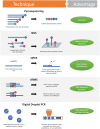Cell-free DNA testing: future applications in gastroenterology and hepatology
- PMID: 31019553
- PMCID: PMC6466469
- DOI: 10.1177/1756284819841896
Cell-free DNA testing: future applications in gastroenterology and hepatology
Abstract
The application of next-generation sequencing in clinical practice is increasing as accuracy and interpretation have improved and the cost continues to decline rapidly. Cell-free DNA is a unique source for next-generation sequencing that could change routine clinical practice in gastroenterology and hepatology. Testing of cell-free DNA in blood and fecal samples is an easy, rapid, and noninvasive method to assess for premalignant, malignant, metabolic, infectious, inflammatory, and autoimmune gastrointestinal and liver diseases. In this review, we describe cell-free DNA technologies, current applications of cell-free DNA testing, and proposed cell-free DNA targets for gastrointestinal and hepatic diseases, with a specific focus on malignancy. In addition, we provide commentary on how cell-free DNA can be integrated into clinical practice and help guide diagnosis, prognosis, disease management, and therapeutic response.
Keywords: cell-free DNA; gastroenterology and hepatology; individualized medicine.
Conflict of interest statement
Conflict of interest statement: The authors declare that there is no conflict of interest.
Figures


Similar articles
-
Individualized Medicine in Gastroenterology and Hepatology.Mayo Clin Proc. 2017 May;92(5):810-825. doi: 10.1016/j.mayocp.2017.03.002. Mayo Clin Proc. 2017. PMID: 28473040 Review.
-
Challenges and opportunities in the application of artificial intelligence in gastroenterology and hepatology.World J Gastroenterol. 2021 Oct 7;27(37):6191-6223. doi: 10.3748/wjg.v27.i37.6191. World J Gastroenterol. 2021. PMID: 34712027 Free PMC article. Review.
-
Artificial intelligence in gastroenterology and hepatology: how to advance clinical practice while ensuring health equity.Gut. 2022 Sep;71(9):1909-1915. doi: 10.1136/gutjnl-2021-326271. Epub 2022 Jun 10. Gut. 2022. PMID: 35688612 Free PMC article. Review.
-
Endoscopic procedures in hepatology: Current trends and new developments.J Hepatol. 2024 Jan;80(1):124-139. doi: 10.1016/j.jhep.2023.08.032. Epub 2023 Sep 18. J Hepatol. 2024. PMID: 37730125 Review.
-
Artificial intelligence in gastroenterology and hepatology: Status and challenges.World J Gastroenterol. 2021 Apr 28;27(16):1664-1690. doi: 10.3748/wjg.v27.i16.1664. World J Gastroenterol. 2021. PMID: 33967550 Free PMC article. Review.
Cited by
-
Cell-Free DNA: Potential Application in COVID-19 Diagnostics and Management.Viruses. 2022 Feb 4;14(2):321. doi: 10.3390/v14020321. Viruses. 2022. PMID: 35215914 Free PMC article. Review.
-
Global DNA hypomethylation of colorectal tumours detected in tissue and liquid biopsies may be related to decreased methyl-donor content.BMC Cancer. 2022 Jun 2;22(1):605. doi: 10.1186/s12885-022-09659-1. BMC Cancer. 2022. PMID: 35655145 Free PMC article.
-
Towards systematic nomenclature for cell-free DNA.Hum Genet. 2021 Apr;140(4):565-578. doi: 10.1007/s00439-020-02227-2. Epub 2020 Oct 29. Hum Genet. 2021. PMID: 33123832 Free PMC article. Review.
-
Donor-Derived Cell-Free DNA in Kidney Transplantation as a Potential Rejection Biomarker: A Systematic Literature Review.J Clin Med. 2021 Jan 7;10(2):193. doi: 10.3390/jcm10020193. J Clin Med. 2021. PMID: 33430458 Free PMC article. Review.
-
DNA Methylation in Urine and Feces Indicative of Eight Major Human Cancer Types Globally.Life (Basel). 2025 Mar 17;15(3):482. doi: 10.3390/life15030482. Life (Basel). 2025. PMID: 40141826 Free PMC article. Review.
References
-
- Schwarzenbach H, Hoon DS, Pantel K. Cell-free nucleic acids as biomarkers in cancer patients. Nat Rev Cancer 2011; 11: 426–437. - PubMed
-
- Fleischhacker M, Schmidt B. Circulating nucleic acids (CNAs) and cancer–a survey. Biochim Biophys Acta 2007; 1775: 181–232. - PubMed
-
- Barták B, Spisák S, Solymosi N, et al. Metagenome analysis of plasma derived CFDNA in healthy patients and colon diseases. Zeitschrift für Gastroenterologie 2013; 51: A9.
Publication types
LinkOut - more resources
Full Text Sources

